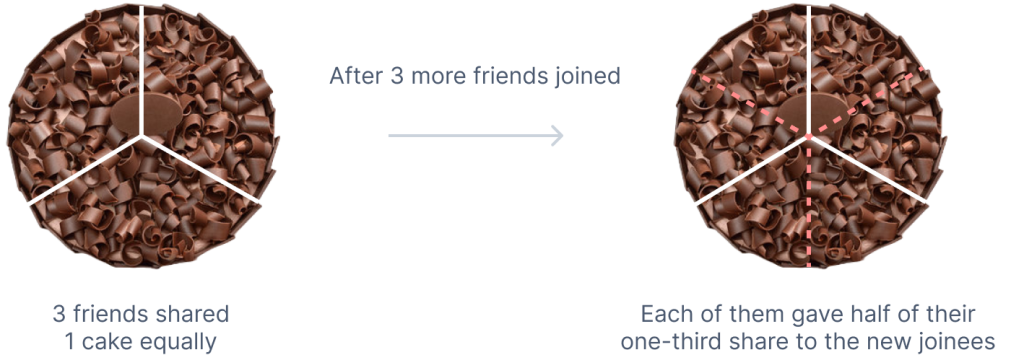Multiplying Fractions
January 13, 2023

When multiplying fractions, first multiply the given numerators, then multiply the given denominators. The resultant fraction must then be further simplified and, if necessary, reduced to its simplest form. When multiplying fractions the denominators do not necessarily need to match, unlike with adding or subtracting fractions.
Properties of Multiplying Fractions
- When you multiply two fractions, their numerators are combined to form the new numerator, and their combined denominators become the new denominator.
- Two fractions are said to be the multiplicative inverse of one another if the product of those fractions is one.
- When a fraction is multiplied by 1, the result is the fraction itself. So, \( \frac{3}{7} × 1 = \frac{3}{7} \).
Example: A group of 3 friends equally divided a cake among themselves. Later three more friends joined them. So, they decided to give the new joiners half their share. What fraction of cake did each one of them get?
Three friends shared one cake equally, later three other friends joined the group:
Fraction of cake shared by each friend = \( \frac{1}{3} \)
After three more friends joined the group, every 3 gave half their share.
Fraction of cake shared by each friend = \( \frac{1}{2} × \frac{1}{3} \)
= \( \frac{1}{6} \) of the cake
So, each of them got one-sixth of the cake.

Multiplying Fractions with Whole Numbers
The idea of multiplying fractions by whole numbers is simple. Since we already know that multiplication is simply the same number added more than once, we can also use this knowledge to multiply fractions.
Steps of Multiplying Fractions with Whole Numbers
We apply the straightforward rule of multiplying the numerators, multiplying the denominators, and then reducing them to the lowest terms to multiply fractions with whole numbers. Whole numbers, however, are written in the fractional form by adding “1” to the denominator. Let’s use an example to grasp this better.
Example: Multiply \( 5 × \frac{7}{4} \)
To multiply the given fraction with a whole number. Follow these steps:
- Here, 5 is a whole number. We can write it as 5/1, and it can be multiplied as we multiply regular fractions.
- We need to multiply \( \frac{5}{1} × \frac{7}{4} \)
- Multiply the numerators, \( 5 × 7 = 35 \)
- Multiply the denominators, \( 1 × 4 = 4 \)
- The resultant product is \( \frac{35}{4} \), and we cannot reduce it further.
- Since \( \frac{35}{4} \) is an improper fraction, we will change it to a mixed fraction, \( \frac{35}{4} \) = \( 8\frac{3}{4} \)
Or you can use our online Fraction Calculator to multiply fractions.
Multiplying Fractions with Mixed Numbers
Mixed numbers consist of a proper fraction and a whole number. But, how to multiply mixed fractions? For that, we need to change the mixed fractions into improper fractions before multiplying. For example, if the number is \( 3\frac{2}{3} \), we need to change this to \( 3\frac{11}{3} \). Let’s take an example.
Example: Multiply \( 3\frac{2}{3} \) and \( 3\frac{7}{4} \).
We can use the following steps to multiply fractions with mixed numbers.
- Change the given mixed fractions to improper fractions, i.e., \( \frac{11}{3} × \frac{19}{4} \).
- Then, multiply the numerators of the improper fractions
- And then multiply the denominators. This will give \( \frac{209}{12} \).
- Further, convert the answer back to a mixed fraction of \( 17\frac{5}{12} \).
What is meant by fractions?
The fraction is a ratio of two numbers. Therefore, we can write the fraction in the form “\( \frac{x}{y} \)”. The top number “x” is called the numerator, and the bottom number “y” is called the denominator.
How to Multiply Fractions with Decimals?
To multiply fractions with decimals, we need to convert the decimal number to a fraction, and then we use the same rules of multiplication of fractions. For example, let us multiply \( \frac{5}{9} × 0.9 \).
- We will convert 0.9 to its fraction form, making it \( \frac{9}{10} \).
- Now, we will traditionally multiply \( \frac{5}{9} × \frac{9}{10} \).
- We will multiply the numerators, \( 5 × 9 = 45 \).
- We will multiply the denominators, \( 9 × 10 = 90 \).
- Thus, the resultant fraction will be \( \frac{45}{90}\). We can reduce it further to \( \frac{1}{2} \).
Alternatively, you can use our free online Multiplying Fractions Calculator.
Can't find your query?
Fill out the form below with your query and we will get back to you in 24 hours.


